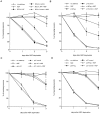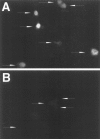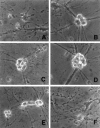Cyclin dependent kinase inhibitors and dominant negative cyclin dependent kinase 4 and 6 promote survival of NGF-deprived sympathetic neurons
- PMID: 9364045
- PMCID: PMC6573623
- DOI: 10.1523/JNEUROSCI.17-23-08975.1997
Cyclin dependent kinase inhibitors and dominant negative cyclin dependent kinase 4 and 6 promote survival of NGF-deprived sympathetic neurons
Abstract
Neuronal apoptosis plays a critical role in both normal development and disease. However, the precise molecular events controlling neuronal apoptosis are not well understood. Previously, we hypothesized that cell cycle regulatory molecules function in controlling the apoptotic pathways of trophic factor-deprived neurons. To test this hypothesis, we used the RNA alphavirus Sindbis to express three known cyclin dependent kinase inhibitors (CKIs), p16(ink4), p21(waf/cip), and p27(kip1), and dominant negative mutant forms of four known G1 cyclin dependent kinases (CDKs), Cdk2, Cdk3, Cdk4, and Cdk6, in primary cultured rat superior cervical ganglion sympathetic neurons. We demonstrate that expression of each of the CKIs protects the postmitotic cultured neurons from apoptotic death evoked by withdrawal of NGF. In addition, we show that expression of dominant negative forms of Cdk4 or Cdk6, but not Cdk2 or Cdk3, protects NGF-deprived sympathetic neurons from death. Such findings suggest the participation of several CDKs and their cognate cyclins in a neuronal apoptotic pathway.
Figures






Similar articles
-
Cyclin-dependent kinases participate in death of neurons evoked by DNA-damaging agents.J Cell Biol. 1998 Oct 19;143(2):457-67. doi: 10.1083/jcb.143.2.457. J Cell Biol. 1998. PMID: 9786955 Free PMC article.
-
Cell cycle exit during terminal erythroid differentiation is associated with accumulation of p27(Kip1) and inactivation of cdk2 kinase.Blood. 2000 Oct 15;96(8):2746-54. Blood. 2000. PMID: 11023508
-
Differential effects of the cyclin-dependent kinase inhibitors p27(Kip1), p21(Cip1), and p16(Ink4) on vascular smooth muscle cell proliferation.Circulation. 2000 May 2;101(17):2022-5. doi: 10.1161/01.cir.101.17.2022. Circulation. 2000. PMID: 10790340
-
[Molecular mechanisms controlling the cell cycle: fundamental aspects and implications for oncology].Cancer Radiother. 2001 Apr;5(2):109-29. doi: 10.1016/s1278-3218(01)00087-7. Cancer Radiother. 2001. PMID: 11355576 Review. French.
-
Programmed cell death in neurons: focus on the pathway of nerve growth factor deprivation-induced death of sympathetic neurons.Mol Pharmacol. 1997 Jun;51(6):897-906. doi: 10.1124/mol.51.6.897. Mol Pharmacol. 1997. PMID: 9187255 Review.
Cited by
-
p19(Ink4d) and p21(Cip1) collaborate to maintain the postmitotic state of auditory hair cells, their codeletion leading to DNA damage and p53-mediated apoptosis.J Neurosci. 2007 Feb 7;27(6):1434-44. doi: 10.1523/JNEUROSCI.4956-06.2007. J Neurosci. 2007. PMID: 17287518 Free PMC article.
-
Cyclin-dependent kinases as a therapeutic target for stroke.Proc Natl Acad Sci U S A. 2000 Aug 29;97(18):10254-9. doi: 10.1073/pnas.170144197. Proc Natl Acad Sci U S A. 2000. PMID: 10944192 Free PMC article.
-
Multiple cyclin-dependent kinases signals are critical mediators of ischemia/hypoxic neuronal death in vitro and in vivo.Proc Natl Acad Sci U S A. 2005 Sep 27;102(39):14080-5. doi: 10.1073/pnas.0500099102. Epub 2005 Sep 15. Proc Natl Acad Sci U S A. 2005. PMID: 16166266 Free PMC article.
-
Activation of serine/threonine protein phosphatase-1 is required for ceramide-induced survival of sympathetic neurons.Biochem J. 2005 Feb 1;385(Pt 3):685-93. doi: 10.1042/BJ20040929. Biochem J. 2005. PMID: 15361069 Free PMC article.
-
Axotomy-induced early down-regulation of POU-IV class transcription factors Brn-3a and Brn-3b in retinal ganglion cells.J Mol Neurosci. 2005;26(1):17-25. doi: 10.1385/JMN:26:1:017. J Mol Neurosci. 2005. PMID: 15968082
References
-
- Berry DE, Lu Y, Schimdt B, Falon PG, O’Connell C, Hu S-X, Xu H-J, Blanck G. Retinoblastoma protein inhibits IFN induced apoptosis. Oncogene. 1996;12:1809–1819. - PubMed
-
- Brooks SF, Gibson LA, Rubin LL. Apoptosis induced by NGF-withdrawal from differentiated PC12 cells involves activation of P34cdc2 kinase. Soc Neurosci Abstr. 1993;19:885.
-
- Chellepan SP, Hiebert S, Mudryj M, Horowitz JM, Nevins JR. The E2F transcription factor is a cellular target for the RB protein. Cell. 1991;65:1053–1061. - PubMed
Publication types
MeSH terms
Substances
LinkOut - more resources
Full Text Sources
Other Literature Sources
Miscellaneous
